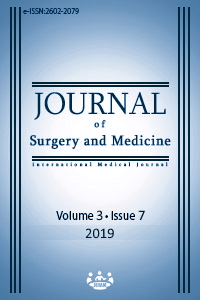The effects of epidural bupivacaine administration for postoperative pain after major abdominal surgery
Keywords:
Epidural analgesia, Bupivacaine, Major abdominal surgeryAbstract
Aim: Postoperative pain is a major problem after major abdominal surgery and conventional intramuscular analgesic therapy is usually not enough. We investigated the effectiveness and timing of epidural patient control analgesia on intraoperative analgesic consumption and postoperative pain, after major abdominal surgery.
Methods: We studied 41 patients prospectively. This was a prospective cohort study. The patients, after ethics committee approval, who were planned to have major abdominal surgery, aged between 35 and 75, were included to the study. 37 patients’ data were included to the study; because two patients were excluded because of motor block developed during research, and 2 patients were excluded because catheter tips were migrated from the epidural space. Epidural catheters were applied to all patients, at proper levels for the surgery, preoperatively. In the first group; bupivacaine infusion was administered postoperatively, via patient controlled analgesia (PCA) machine. In the second group 25 mg bupivacaine bolus was administered before surgery and bupivacaine infusion via PCA was administered at the postoperative period. In the third group 25 mg bupivacaine bolus was administered preoperatively and bupivacaine infusion was administered intra and postoperatively via PCA. Pain levels of the patients were evaluated by using numeric rating scale (NRS). In NRS, patients were asked to evaluate their pain levels between 0 to 10, as 0; no pain and 10 is the worst pain ever.
Results: In all groups postoperative NRS levels were below 4, and sufficient postoperative analgesia was provided. In the third group significant lower analgesia scores and lower intraoperative analgesic consumptions were achieved (P<0.05). In this group arterial blood pressures were lower than the other groups, but they were not lower than the physiologic limits.
Conclusion: Epidural bupivacaine administration is a safe and effective method for postoperative pain management for patients who will have major abdominal surgery.
Downloads
References
Warfield CA, Kahn CH. Acute pain management. Program in U.S. hospitals and experiences and attitudes among U.S. adults. Anesthesiology. 1995;83:1090-4.
Lynch EP, Lazor MA, Gellis JE, Orav J. Patient experience of pain after elective noncardiac surgery. Anesth Analg. 1997;117-23.
John E. Tetzlaff. Regional anesthesia &pain management. In:Morgan GE: Clinical Anesthesiology, First edition. California, USA: Appleton & Lange, 1992:211-212.
Woolf CJ, Chong MS. Preemptive analgesia- Treating postoperative pain by preventing the establishment of central sensitization. Anesth Analg. 1993;77:362-79.
Yashpal K, Katz J, Coderre TJ. Effects of preemptive or postinjury intrathecal local anesthesia on persistent nociceptive responces in rats. Anesthesiology. 1996;84:1119-28.
Kim SH, Chung JM. An experimental model for pheripheral neuropathy produced by segmental spinal nerve ligation in the rat. Pain. 1991;46:327-36.
Rockerman MG, Seeling W, Bischof C. Prophylactic use of epidural mepivacaine/morphine, systemic diclofenac and metimazole reduces postoperative morhine consumption after major abdominal surgery. Anesthesiology. 1996;84:1027-34.
Pedersen JL, Crawford ME, Dahl JB. Effect of preemptive nerve block on inflammation and hyperalgesia after human thermal injury. Anesthesiology. 1996;84:1020-6.
Choe H, Choi YS, Kim YH, Ko SH. Epidural morphine plus ketamine for upper abdominal surgery: Improved analgesia from preincisional versus postincisional administration. Anesth Analg. 1997;84:560-3.
Rice LJ, Pudimat MA, Hannallah RS. Timing of caudal block placement in relation to surgery does not affect duration of postoperative analgesia in peadiatric ambulatory patients. Can J Anaesth. 1990;37(4):429-31.
Liu SS, Carpenter RL, Mackey DC. Effects of perioperative analgesic thecnique on rate of recovery after colon surgery. Anethesiology. 1995;85:757-65.
Dahl JB, Rosenberg J, Hansen BL. Differential analgesic effects of low-dose epidural morphine and morphine-bupivacaine at rest and during mobilization after major abdominal surgery. Aneth Analg. 1992;74:362-5.
Liu SS, Carpenter RL, Neal JM. Epidural anesthesia and analgesia: Their role in postoperative outcome. Anesthesiology. 1995;82:1474-506.
Peach MJ. Epidural analgesia in labor: Constant infusion plus patient controlled boluses. Anesth Intensive Care. 1991;19:32-9.
Gambling DR, McMorland GH, Yu P, Laszlo C. Comparison of patient-controlled epidural analgesia and convential intermittent “toP-upé injections during labor. Anesth Analg. 1990;70:256-61.
Liu SS, Allen HW, Olsson GL. Patient controlled epidural analgesia with bupivacaine and fentanyl on hospital wards. Anesthesiology. 1998;88:688-95.
Kurek SJ, Garcia JL, Casella R, Meenan D, Hughes KM. Complications of epidural infusions for analgesia in postoperative and trauma patients. The American Surgeon. 1977;63:543-6.
Hogan Q. Epidural catheter tip position and distribution of injectate evaluated by computed tomography. Anesthesiology. 1999;90;964-70.
Nakamura T, Yokoo H, Hamakawa T, Takasaki M. [Preemptive analgesia produced with epidural analgesia administered prior to surgery]. Masui. 1994 Jul;43(7):1024-8.
Dahl JB, Hjortso NC, Erichsen CJ, Moiniche S. Influence of timing on the effect of continuous extradural analgesia with bupivacaine and morphine after major abdominal surgery. Br J Anaesth. 1992;69(1):37-40.
Kissin I. Preemptive Analgesia. Anesthesiology. 1996;84:1015-9.
Takahisa G, Marota JJ, Crosby G. Nitrous oxide induces preemptive analgesia in the rat. That is diagnosed by halothane. Anesthesiology. 1994;80(2):8-14.
Downloads
- 1563 2103
Published
Issue
Section
How to Cite
License
Copyright (c) 2019 Yeşim Çetintaş
This work is licensed under a Creative Commons Attribution-NonCommercial-NoDerivatives 4.0 International License.
















